What is Diwali (Deepavali) (full) information (facts) (history) (significance) (importance)
Namaste friends, how are you doing today? Welcome to #BhagavanBhakthi website / blog.
Bhagavan Lord Sri Krishna (Vishnu) (Rama) (Trivikrama) and Goddess Sri Lakshmi blessings to you and your family!
In this website / blog, you will always learn about #Hinduism #Sanskrit language.
Also subscribe to my YouTube channel from this link #BhagavanBhakthi to view videos about #Hinduism #Sanskrit language.
Just before going to “What is Diwali (Deepavali) (full) information (facts) (history) (significance) (importance)“, let us know a brief, basic and very important information.

[Please note that in this post little bit of technical and also the common but very interesting information about Diwali (Deepavali) (Deepawali) is been provided.]
[I urge the readers to read this post fully to get the full information about Diwali (Deepavali) (Deepawali).]
In this post you will learn about Diwali (Deepavali) (Deepawali) as given below:
What is Diwali (Deepavali) (full) information? What are the facts about Diwali (Deepavali)? What is the history of Diwali (Deepavali)?
What is the significance of Diwali (Deepavali)? What is the importance of Diwali (Deepavali)? And much more information.
Diwali is also known as Deepavali or Deepawali. Most of the north Indians use Diwali, and few of the north Indians even use Deepavali or Deepawali.
While in South India, most people use Deepavali or Deepawali and very few use Diwali.
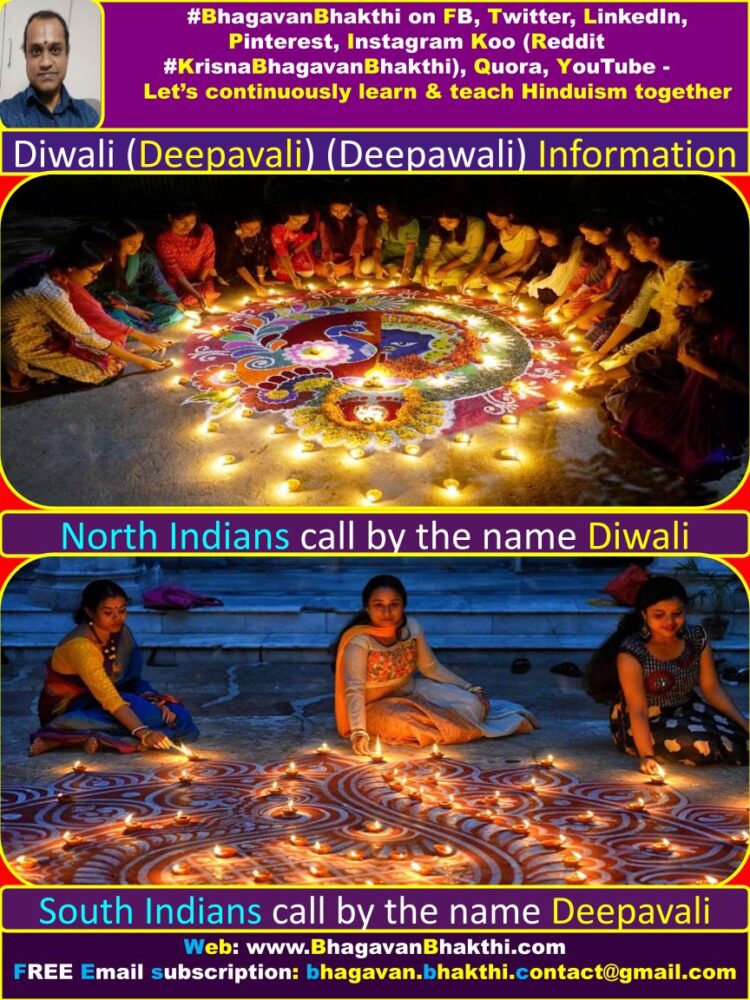
In Sanskrit Diwali or Deepavali or Deepawali is pronounced as दीपवलि (dīpāvaḷi), while in Hindi it is pronounced as दीपावली (dīpāvaḷī).
The word Deepavali (Diwali) meaning is as given below:
Deepavali = Deepa + Vali = Lights (Lamps) (Deepa) (Diya) + row. Thus Deepavali (Deepawali) (Diwali) means, arranging the lights (Deepa) (Diya) in rows.
Diwali (Deepavali) (Deepawali) is one of the most exciting and famous festivals for Hindus. This most grand festival is celebrated by Hindus across the globe.
Divine Diwali (Deepavali) (Deepawali) festival mood starts with buying new dress, preparation of snacks and sweets, doing Ganga snan (bath), bursting crackers, taking early morning oil bath, etc.
As said above, the word Diwali (Deepavali) (Deepawali) is been originated from the divine Sanskrit word “Deepavali” which means “Rows of lights (Deepas) (Deeps) (Diyas) (Lamps)”.
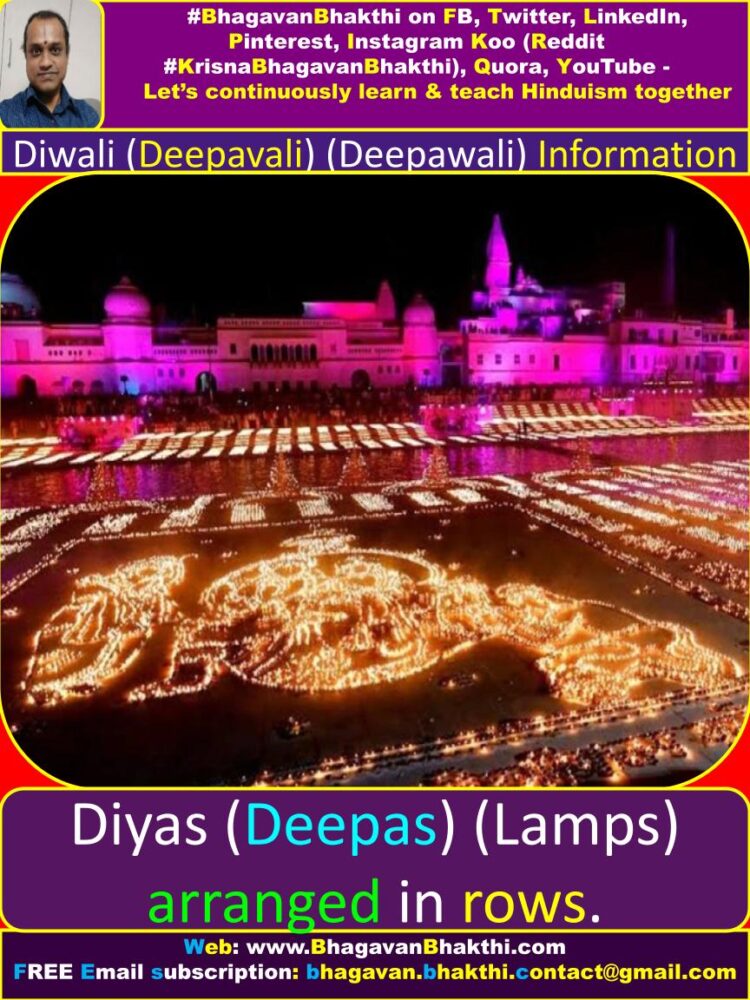
This 5 day long Hindu festival is celebrated throughout the world with great enthusiasm, happiness and bliss. Diwali (Deepawali) (Deepavali) is the festival signifying the victory of good against evil.
It usually occurs in Gregorian calendar in the month of October / November, and is one of the most popular and eagerly awaited festivals not only for Hindus, but even non-Hindus celebrate this festival all over the world.
Diwali comes 3 weeks after Dussehra, also called Dasara or Vijayadashami.
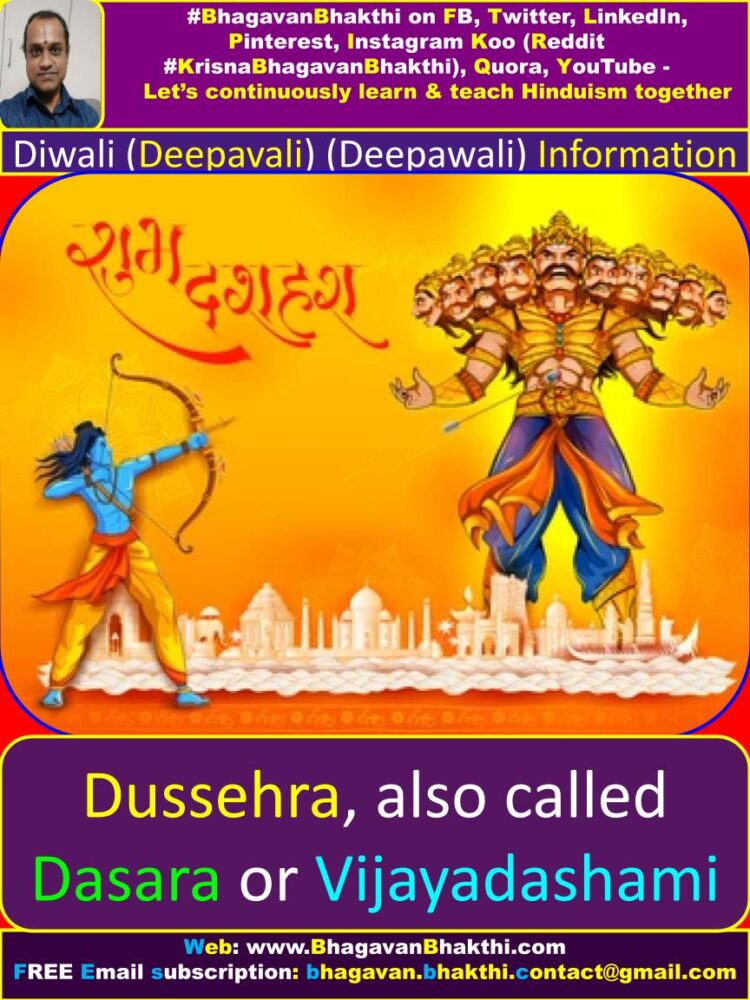
Different rituals performed during the festival of Diwali (Deepavali) (Deepawali) are as given below:
1. Jala poorna Dwadashi : Firstly, on dwadashi day it is called Jala (Neer) poorna dwadashi (to segregate water).
2. Dhana Trayodashi : “Dhana Trayodashi” or “Dhanteras”. Doing pooja of Lord Sri Dhanvantari (An avatar of Lord Sri Vishnu).
3. Naraka Chaturdashi : Significance of Chaturdashi. This is the day when Lord Sri Krishna slayed demon Narakasura. Thus Lord Krishna is called as Narakari.
4. Amavasya Lakshmi Pooja : Lakshmi Pooja significance. Goddess Sri Lakshmi Devi pooja is done on this day.
5. Bali Padyami : Bali Padyami importance. King Bali (Mahabali) was given the boon by Lord Sri Vamana (An avatar of Lord Sri Vishnu) as below:
King Bali (Mahabali) will be allowed to rule the entire universe for one day in an year, and on that day he can visit the earth, which is called as the Bali Padyami day, that is on the Kartika Shukla Paksha on Padya (Padyami) day.
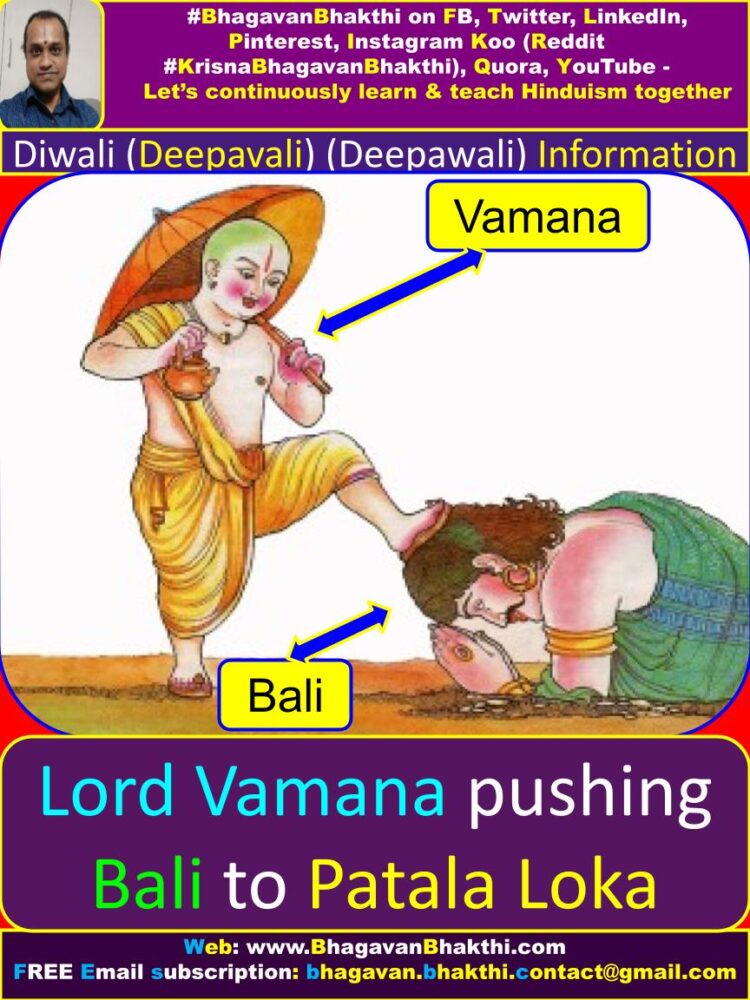
Now, let us know all the above in detail:
Firstly, on dwadashi it is called Jala (Neer) poorna dwadashi (to segregate water).
This is popularly called as Jala poorana (poorna) dwadashi or water filling day of festival.
What is this Jala (Neer) Dwadashi?
‘Neer’ means water (jala) and the tradition of physically cleaning and refilling the container. This cleaning is done to remove all dirt, evil and inauspicious things before the entry of Goddess Sri Maha Lakshmi Devi during Diwali (Deepavali) day.
This is done on Ashwayuja month, Krishna paksha, trayodashi day (taking bath on trayodashi, while to segregate the water on dwadashi day, that is one day before trayodashi day).
This is popularly called as Jala poorana (purna) (poorna) trayodashi / festival of segregating the water on thirteenth day (As per Hindu calendar).
On Ashwayuja (Ashvin) month Krishna paksha, trayodashi day, we have to do the Ganga pooja. We have to clean the haNDa (handi) (a big pot).
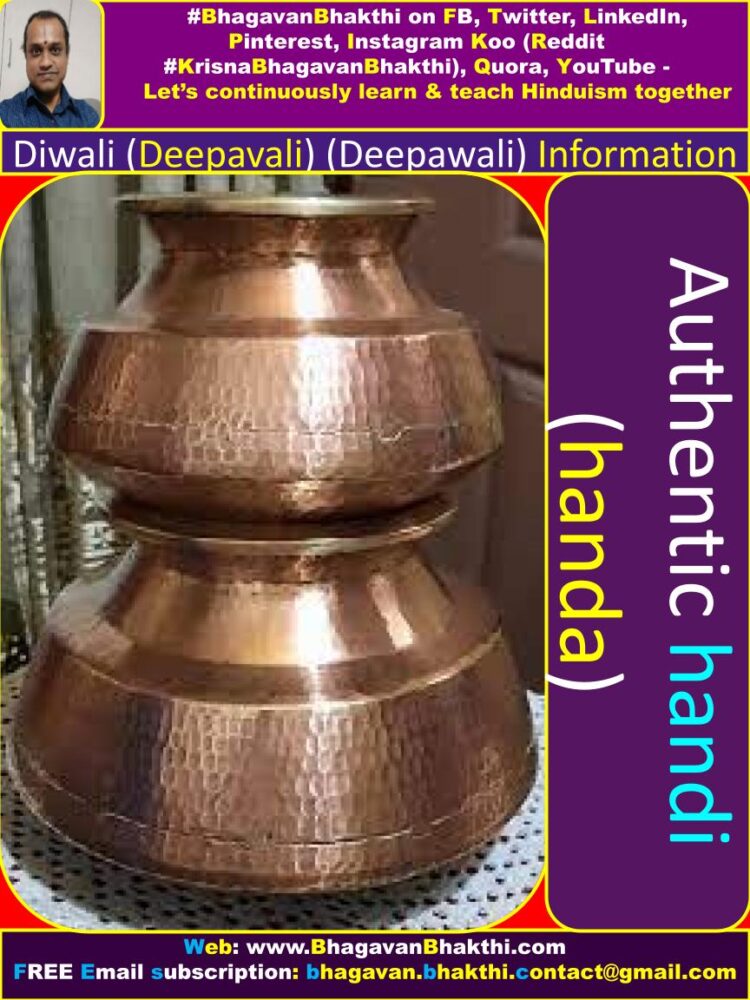
Of course, now a days, we are rarely seeing haNDa (handi) (a big pot), those who are not having haNDa (handi) (a big pot), they have to clean their geyser, boiler, etc.
We have to fill the haNDa (handi) (a big pot), geyser, boiler with fresh water, and should decorate with rangavalli (rangoli), do the avaahana (avahan) of Goddess Sri Ganga Devi and other tirthas (rivers) – remember the rivers’ names by chanting the below shloka –
Achamana, saNkalpa……….. kalasha (kalash) pUja …..गंगेच यमुनेचैव गोदावरि सरस्वति | नर्मदे सिंधु कावेरि जलेस्मिन् सन्निधिं कुरु ||
ಗಂಗೇಚ ಯಮುನೇಚೈವ ಗೋದಾವರಿ ಸರಸ್ವತಿ | ನರ್ಮದೇ ಸಿಂಧು ಕಾವೇರಿ ಜಲೇಸ್ಮಿನ್ ಸನ್ನಿಧಿಂ ಕುರು ||
gaṅgēca yamunēcaiva gōdāvari sarasvati | narmadē sindhu kāvēri jalēsmin sannidhiṁ kuru ||
Meaning of the above shloka : In this water (The water used for bath), I invoke the presence of divine waters from the most auspicious rivers Ganga, Yamuna, Godavari, Sarasvati, Narmada, Sindhu and Kaveri.
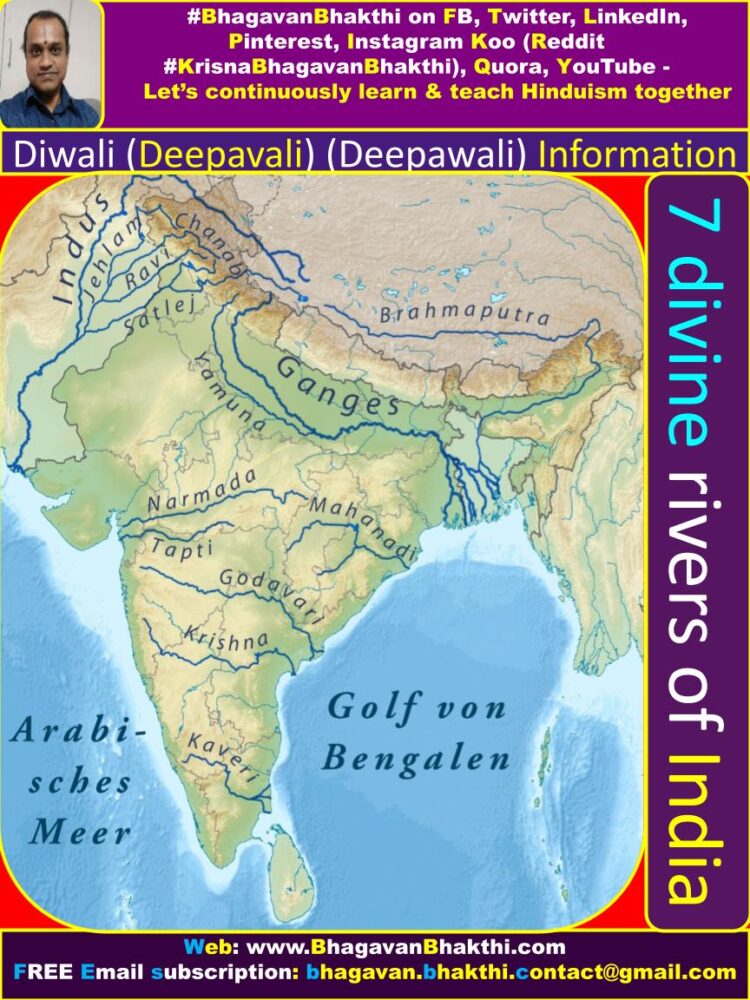
You can also chant the following names of Goddess Sri Ganga Devi as given below:
naMdinai nama: | nalinyai nama: | sItaayai nama: | maalatyai nama: | malaapahaayai nama: | viShNupaadaabhasaMbhUtaayai nama: |
gaNgaayai nama: | tripathagaaminyai nama: | bhaagIrathyai nama: | bhOgavatyai nama: jaahnavyai nama: | tradashEshvaryair nama: |
And later you can chant this as given below:
dhUpaM, dIpaM, gUDaapUpa naivEdyaM samarpayaami | nIraajanaM samarpayaami | naivEdyaM samarpayaami.
After naivEdya samarpaNa, pour the kalasha (kalash) water to the haNDa (handi), boiler, etc. Next day morning use the water for bath.
Secondly, Dhana trayodashi (Dhanteras) day, is the day when Lord Sri Vishnu takes the avatar as Lord Sri Dhanvantari (Sri Vaidyo Narayana Hari – Sri Hari take avatar of a physician).
On this day, Lord Sri Dhanvantari brings ‘Amruta (Amrita)’ (during the Sagara Manthana / Sagar manthan / Samudra Manthana / Samudra Manthan).
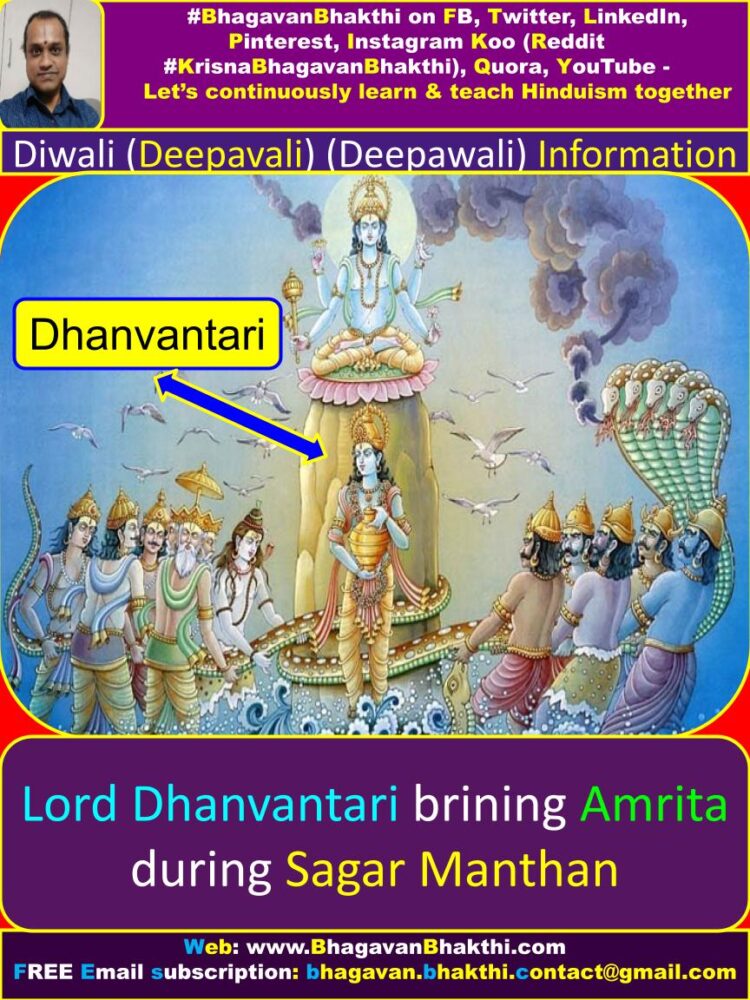
Information bbout “Dhana Trayodashi or Dhanteras” is as given below:
It is observed on the thirteenth day (As per Hindu calendar) of the Ashwija month Krishna Paksha., i.e., on Trayodashi day in Ashwija month, Krishna Paksha. Dhanteras is the other name for Dhana Trayodashi.
“Dhana” means ‘wealth’ and ‘teras’ indicates ‘the thirteenth day’. “Deepadaana (Deep daan)” is an important ritual observed on Dhana trayodashi (Dhanteras) day.
Lamps are lit in the name of all family members and ancestors and they are floated in a river or pond. Dhana trayodashi (Dhanteras) is also observed as Yamadeepa daana (Yama Deep daan) by many communities.
Goddess Sri Lakshmi Devi is welcomed into the house on this day in many regions in the evening. Rangoli is drawn on doorways and tiny footprints of Goddess Sri Lakshmi Devi are drawn in to symbolize her arrival.
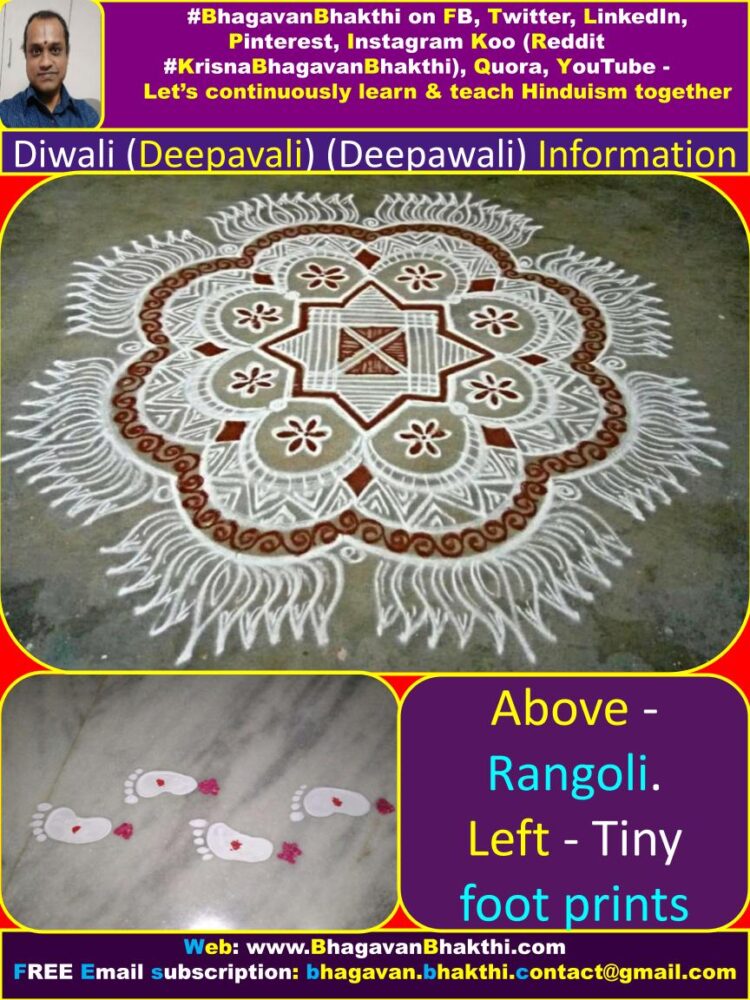
Devotional songs dedicated to Goddess Sri Lakshmi Devi are sung in the evening. Naivedya (Also called as bhog in north India) is offered to the Goddess Sri Laskhmi Devi on the day.
A new utensil of gold or silver is bought for the house on the Dhana trayodashi (Dhanteras) day. Some people also make it a point to make an investment on the day as it is believed that investments made on this day will be appreciated.
Most people also wait for the day to purchase and give away Diwali gifts on this day.
Story behind Dhana Trayodashi (Dhanteras) is as given below:
Once Goddess Sri Maha Lakshmi Devi accompanied by Lord Sri Vishnu in his Yatra (travel) to bhulokam (Earth) and told her not to fall for earthly temptation and she must not look in the southern direction.
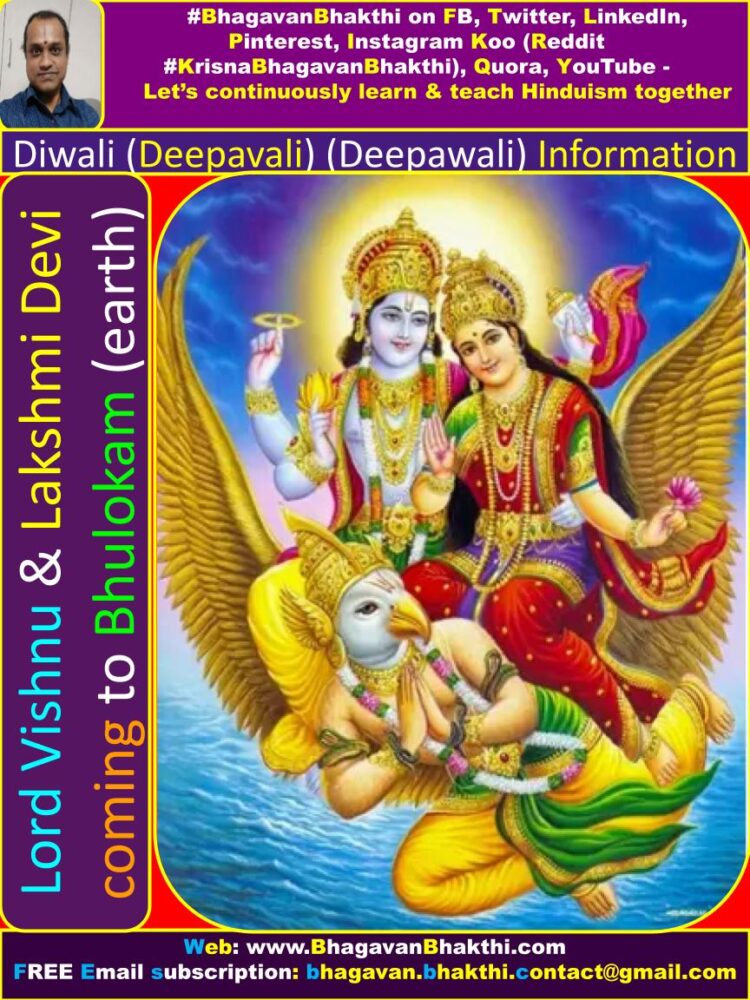
But Goddess Sri Maha Lakshmi Devi was tempted to look in the southern direction and when she got an opportunity she looked in the southern direction.
In the south, direction she saw yellow mustard flowers, sugarcane fields and started dancing in the fields and decorated herself with the flowers and was enjoying the sugarcane juice.
Goddess Sri Maha Lakshmi Devi fell for earthly temptations. Lord Sri Vishnu told Goddess Sri Maha Lakshmi Devi that: “As you have violated the conditions, you will need to spend 12 years as labourer in the field of the person to whom the sugarcane and flowers belonged”.
With the arrival of Goddess Sri Maha Lakshmi Devi as labourer, the farmer became very prosperous.
Twelve years passed and it was time for Goddess Sri Maha Lakshmi Devi to return, but the farmer was not ready to relieve a good labourer.
But Goddess Sri Maha Lakshmi Devi was not ready to stay further. Goddess Sri Maha Lakshmi Devi asked the farmer and his family to take a pilgrimage to Goddess Sri Ganga Devi River and they will decide on her future stay there on his return.
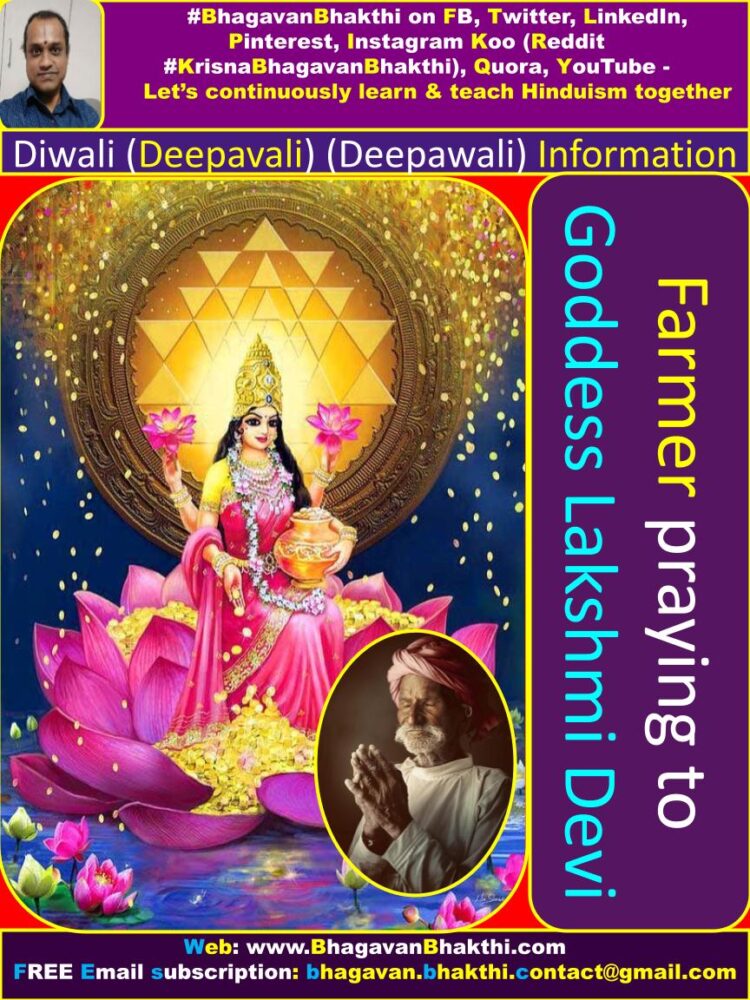
Goddess Sri Maha Lakshmi Devi also gave four small shells to the farmer to offer to Goddess Sri Ganga Devi. When the farmer was offering the shells to Goddess Sri Ganga Devi river, four hands came up and accepted the offering.
Farmer soon realized that the shells he offered was no ordinary shell and the person who gave it was no ordinary woman.
Farmer prayed to Goddess Sri Ganga Devi to enlighten him. Goddess Sri Ganga Devi then revealed that the woman at the farmer’s home was svayam Goddess Sri Maha Lakshmi Devi.
The farmer returned home happily realizing that it was Goddess Sri Maha Lakshmi Devi who was staying in his house. Farmer requested her not to leave. Goddess Sri Maha Lakshmi Devi said that she cannot live on earth permanently and has to return.
But Goddess Sri Maha Lakshmi Devi said that she will visit him on all “Dhana Trayodashi / Dhanteras” Day every year.
Goddess Sri Maha Lakshmi Devi asked the farmer to keep the house clean and light with earthen lamp.
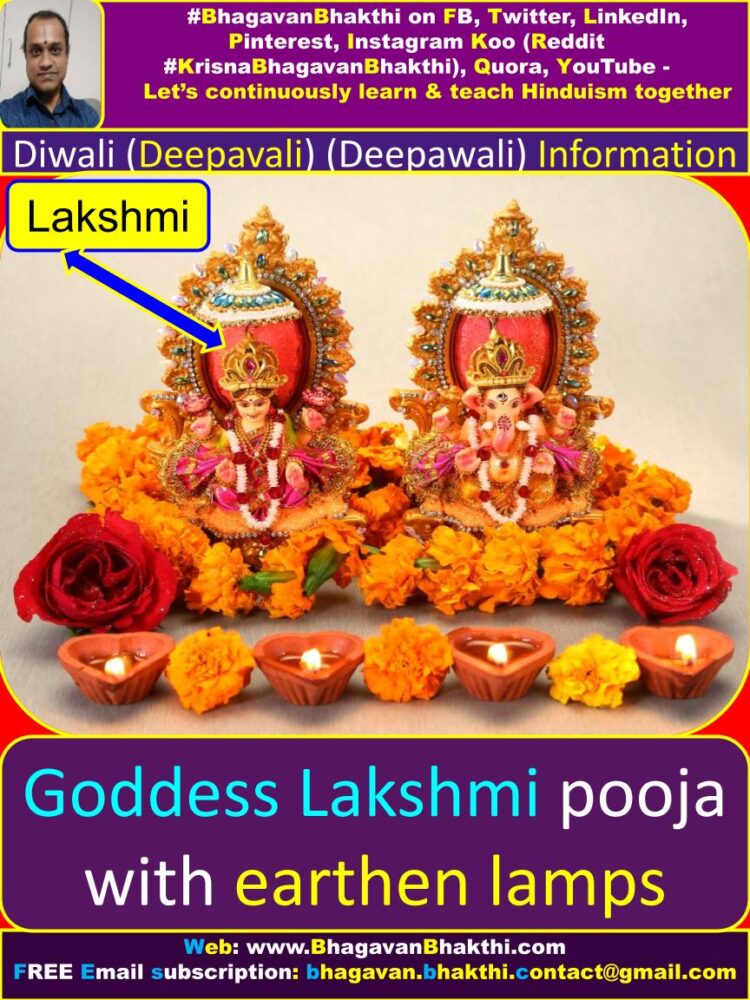
The farmer said as directed by Goddess Sri Maha Lakshmi Devi and he became very prosperous and people who came to know about the incident started performing the same ritual on this day.
(This story is from Skanda Purana collected from different sources)
Story about Dhana Trayodashi and Yamadeepa Daana (Yama Deep Daan) is as given below:
A story about this day is of the sixteen year old son of King Hima. As per his horoscope he was doomed to die by a snake-bite on the fourth day of his marriage.
On that particular fourth day of his marriage his young wife did not allow him to sleep.
She laid all the ornaments and lots of gold and silver coins in a big heap at the entrance of her husband’s boudoir and lighted innumerable diyas (deepas) (lamps) all over the place.
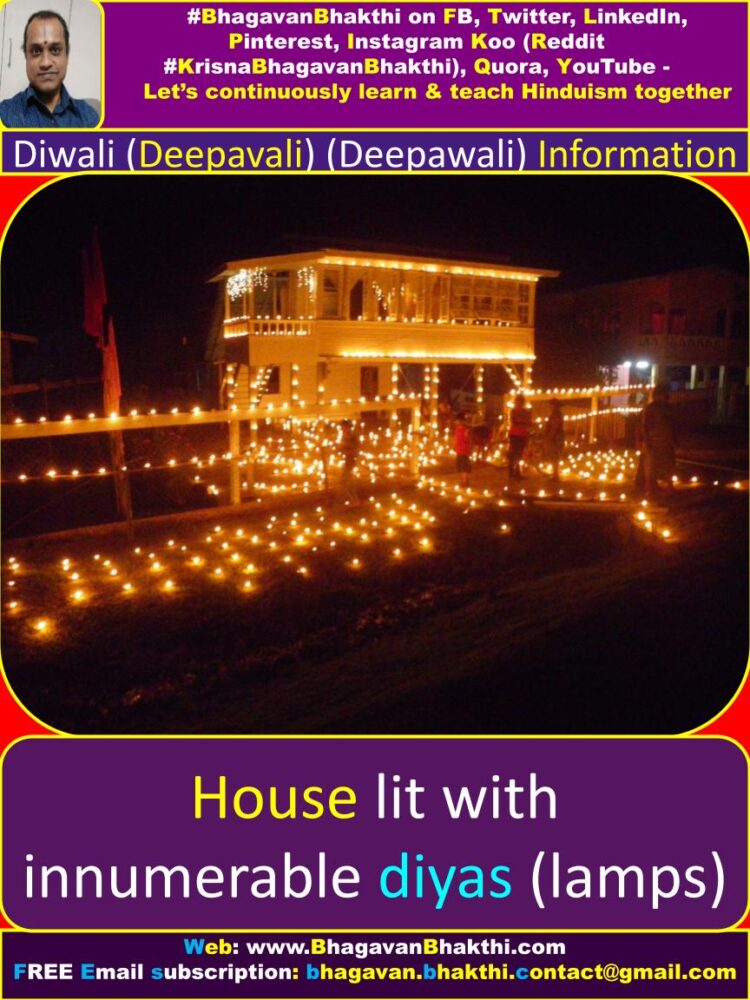
And she went on telling stories and singing songs. When Lord Sri Yama Deva, the god of Death arrived there in the guise of a Serpent his eyes got blinded by that dazzle of those brilliant lights and he could not enter the Prince’s chamber.
So he climbed on top of the heap of the ornaments and coins and sat there whole night listening to the melodious songs. In the morning he quietly went away. Thus the young wife saved her husband from the clutches of death.
Since then this day of Dhanteras (Dhana Trayodashi) came to be known as the day of “YAMA DEEPA DAANA” (Yama Deep Daan) and lamps are kept burning throughout the night in reverential adoration to Lord Sri Yama Deva, the god of Death.
According to another popular legend, when the Devatas (Demigods) and demons churned the ocean (Samudra Manthan) for Amrita or nectar –
Lord Sri Dhanvantari (the physician of the gods and an avatar of Lord Sri Maha Vishnu) emerged carrying a jar of the amrita on this day of Dhana Trayodashi (Dhanteras) during Sagar Manthan (Samudra Manthan).
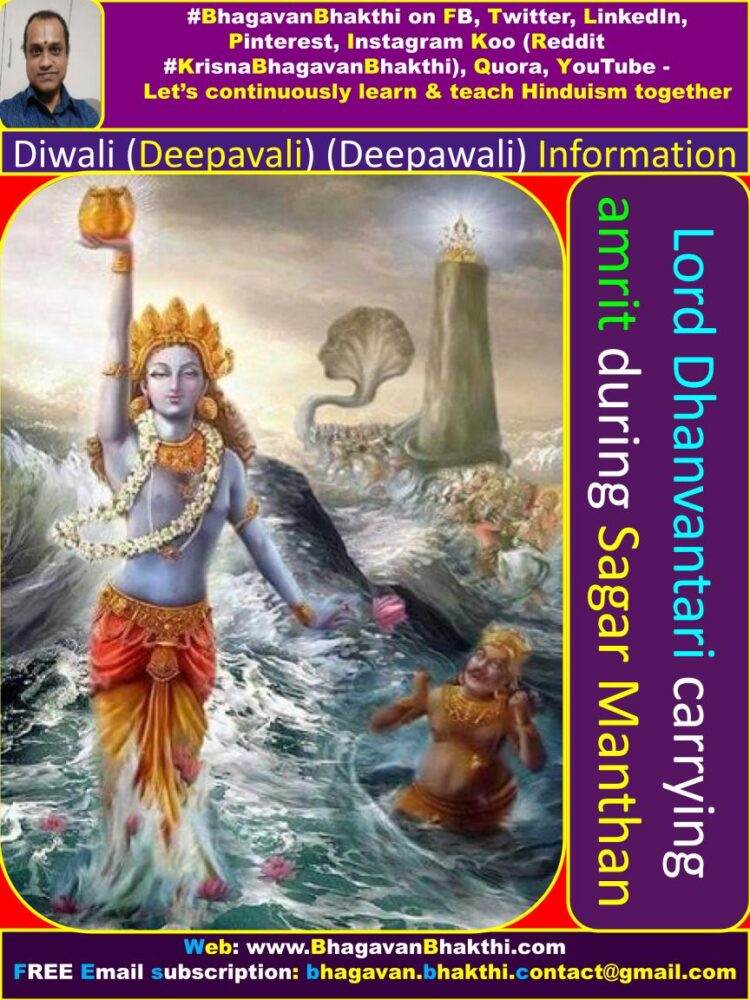
What is Naraka Chaturdashi?
During the third day, that is, on Chaturdashi day, Lord Sri Krishna kills the rakshasa (demon) Narakasura. That’s why the name Sri Naraka Chaturdashi.
[Since Lord Sri Krishna killed rakshasa (demon) Narakasura, Lord Sri Krishna is also known as Narakari.]
Naraka Chaturdashi is celebrated to mark the end of Narakasura named daitya (rakshasa) (demon). It is celebrated on Ashwija month, Krishna Paksha, Chaturdashi day.
Who is Narakasura?
Narakasura was a daitya (demon) (rakshasa) born to Goddess Sri Bhoodevi and Lord Sri Varaha Svami (An avatar of Lord Sri Vishnu).
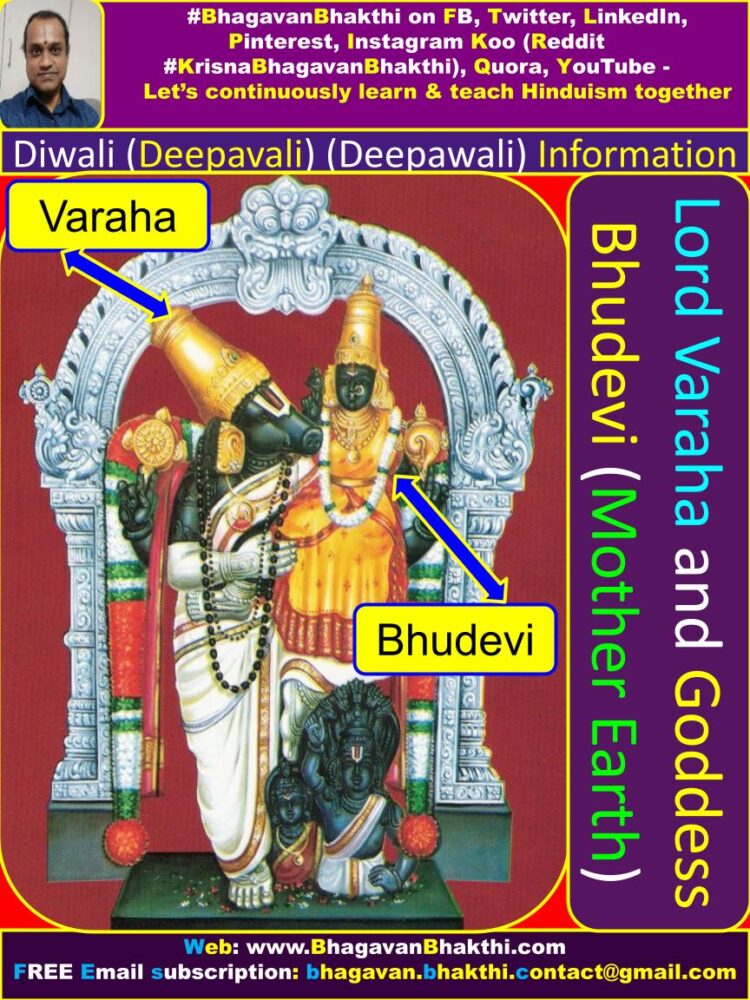
Narakasura was the king of Pragjyotisha Nagar (Now in Assam). He had occupied that King’s position after overthrowing another demon named King Ghatakasura.
Narakasrua did a severe penance to please Lord Sri Brahma Deva. Narakasura asked Lord Sri Brahma Deva to bestow a boon that he shall die only in the hands of Goddess Sri Bhoodevi, his mother.
Narakasura did not asked the boon of immortality, as he was sure that Lord Sri Brahma Deva can’t give that boon.
(Lord Sri Vishnu can give the boon of immortality.)
Thus for this reason, Narakasura asked the boon that, he should be killed by only at the hands of Goddess Sri Bhoodevi.
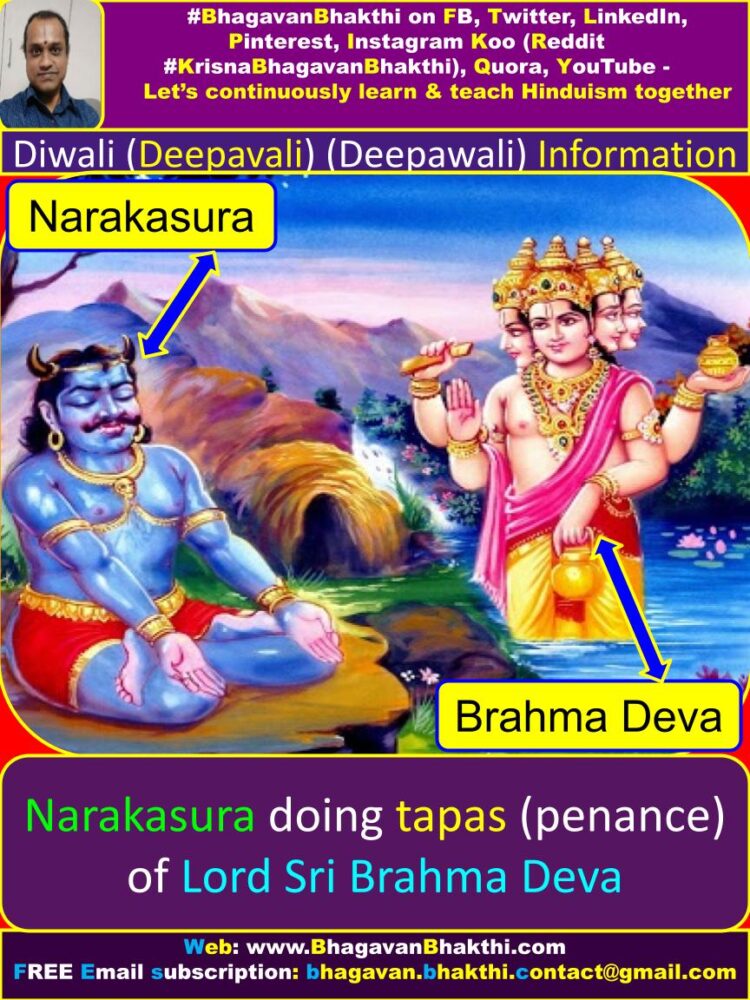
Why Lord Sri Krishna & Satyabhama Devi killed Narakasura?
Narakasura in association with Murasura, had brought control of the entire world under his belt.
Narakasura went to Svarga Loka and attacked Lord Sri Indra Deva (As called as Devendra), who had to flew out of Indraloka (Svarga Loka).
Narakasura stole 16100 women (They are originally children of Agni, born as ladies just to marry to Lord Sri Krishna) and Narakasura had kept them in his Jail.
Narakasura was very much arrogant, he didn’t even let Aditi Devi, the mother of the Devatas (Demigods).
Aditi Devi, had some precious heavenly ear rings, which was glowing even in the dark. Narakasura tore the ear rings from Aditi Devi, and took it away.
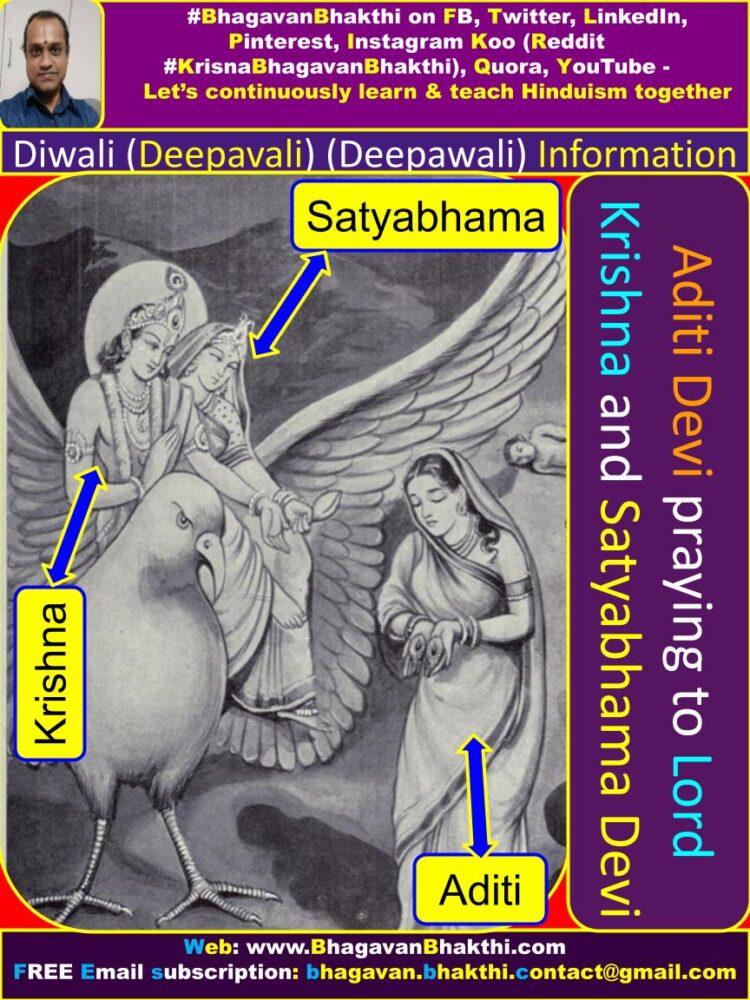
Aditi Devi, the mother of Devatas (Demigods) approached Satyabhama Devi for help, who in turn approached Lord Sri Krishna. Narakasura had 11 Akshohini Sainya.
All the Devatas (Demigods) approached Lord Sri Vishnu with the leadership of Lord Sri Indra Deva, who assured them to put an end to Narakasura.
But Narakasura had a boon that he would face death only at the hands of his mother Goddess Sri Bhoodevi. So, Lord Sri Krishna asks his wife Satyabhama Devi, the reincarnation of Goddess Sri Bhudevi (Bhoodevi).
(We need to remember that, Satyabhama Devi is the partly incarnation of Goddess Sri Bhudevi. While Satyabhama Devi was an original incarnation / avatar of Goddess Sri Maha Lakshmi Devi).
Satyabhama Devi became the charioteer of Lord Sri Krishna in the battle with Narakasura and their vehicle or mount was Lord Sri Garuda Deva.
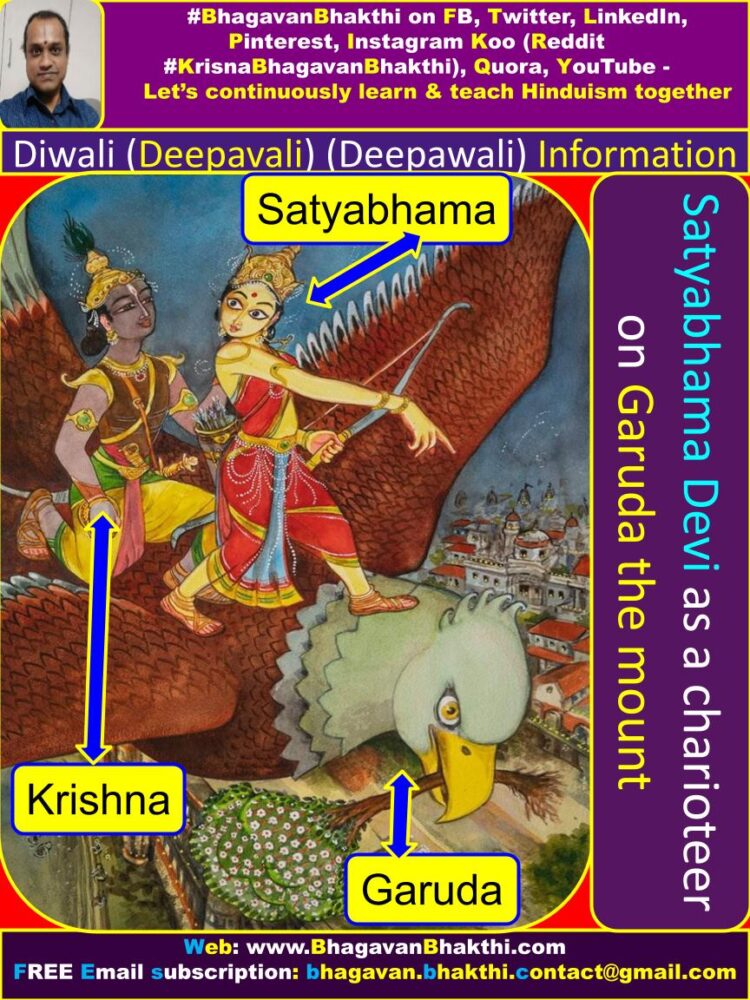
Lord Sri Krishna went along with Satyabhama Devi, attacked Narakasura and his fort, riding on his chariot Lord Sri Garuda Deva.
Narakasura’s palace was guarded by the five-headed daitya / demon called as Murasura. Murasura hurled countless weapons at Lord Sri Krishna, but Lord Sri Krishna shot each one down with his bow and arrow.
Then Lord Sri Krishna killed him with his Sudarshana Chakra dislocating Mura’s five heads.
(For this reason, Lord Sri Krishna Deva got the name “Murari”. Here, Murari means someone who has killed the daitya / demon called as Mura or Murasura.)
Then a fierce fight went on with Lord Sri Krishna and the rakshasa (daitya) (demon) Narakasura began. Satyabhama Devi also joined in fighting against the demon Narakasura.
Later, Lord Sri Krishna killed Narakasura with his Sudarshana Chakra and freed all the 16,100 women who were imprisoned by the demon Narakasura.
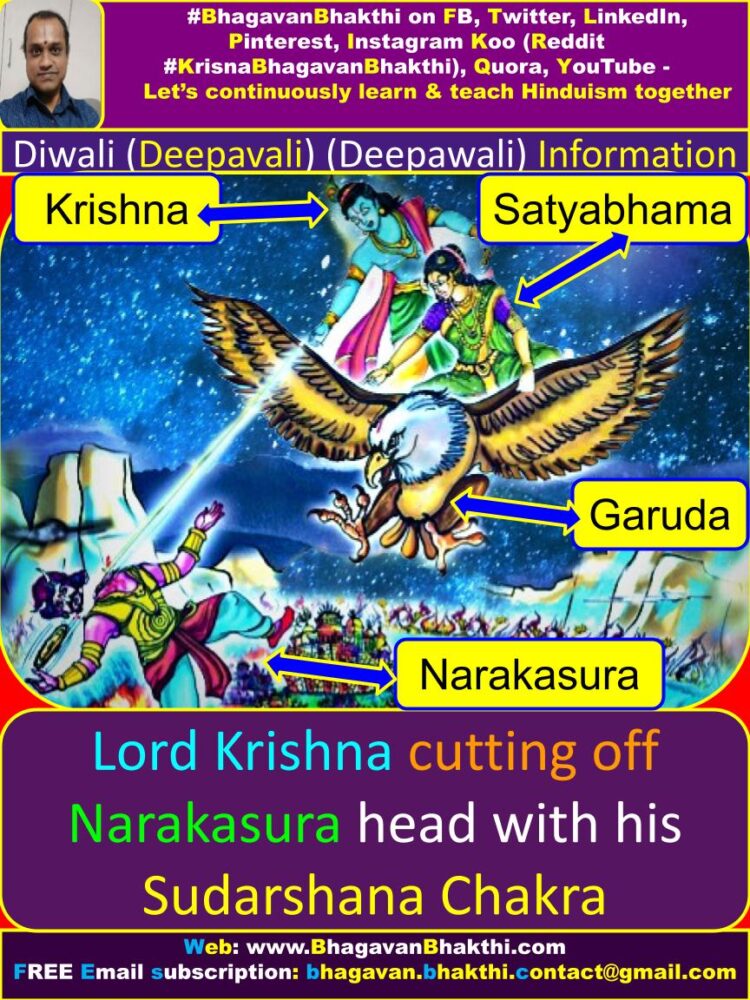
Goddess Sri Bhudevi then praises Lord Sri Krishna and begged him to take Narakasura’s son Bhagadatta under his protection.
Lord Sri Krishna placed Bhagadatta (Narakasura’s son Bhagadatta who had fought for Kauravas in Kurukshetra War) on the throne and then freed all prisoners.
The Devatas (Demigods) showered Lord Sri Krishna with flowers from the higher planets like Svarga Loka etc.
Before dying, Narakasura, requested a boon that his death anniversary should be celebrated by all people on earth with colorful lights.
Lord Sri Vishnu / Lord Sri Hari / Lord Sri Krishna is also known as “Narakari” as Lord Sri Krishna killed Narakasura.
Here, Narakari means someone who has killed the daitya / demon Narakasura. This day is celebrated as ‘Naraka Chaturdashi’ – Narakasura’s death is celebrated as the victory of light over darkness.

Why oil bath to be taken on Naraka Chaturdashi day?
It is said Lord Sri Krishna had an oil bath to rid himself off the blood spattered on his body when Narakasura was killed.
The tradition is followed and people offer prayers on the previous day of the Naraka Chaturdashi to the vessel in which water is being heated for having bath. Hindus light fireworks, which are regarded as the effigies of Narakasura who was killed on this day.
Taking OIL-BATH is a must on this day. That is, Goddess Sri Maha Lakshmi Devi will be getting from the bed. It has been said to perform pooja according to usage and custom.
Lord Sri Krishna has given a blessing on Narakasura, that those who does the tailabhyanjana (Oil bath) on this day, i.e.,
On Ashwayuja month, Chaturdashi day, Krishna Paksha will have putra (sons), poutra (grandsons), aishwarya (wealth) and many other divine things.
This is called as “Naraka Chaturdashi”, further they will not have the fear of “Naraka / Hell”.
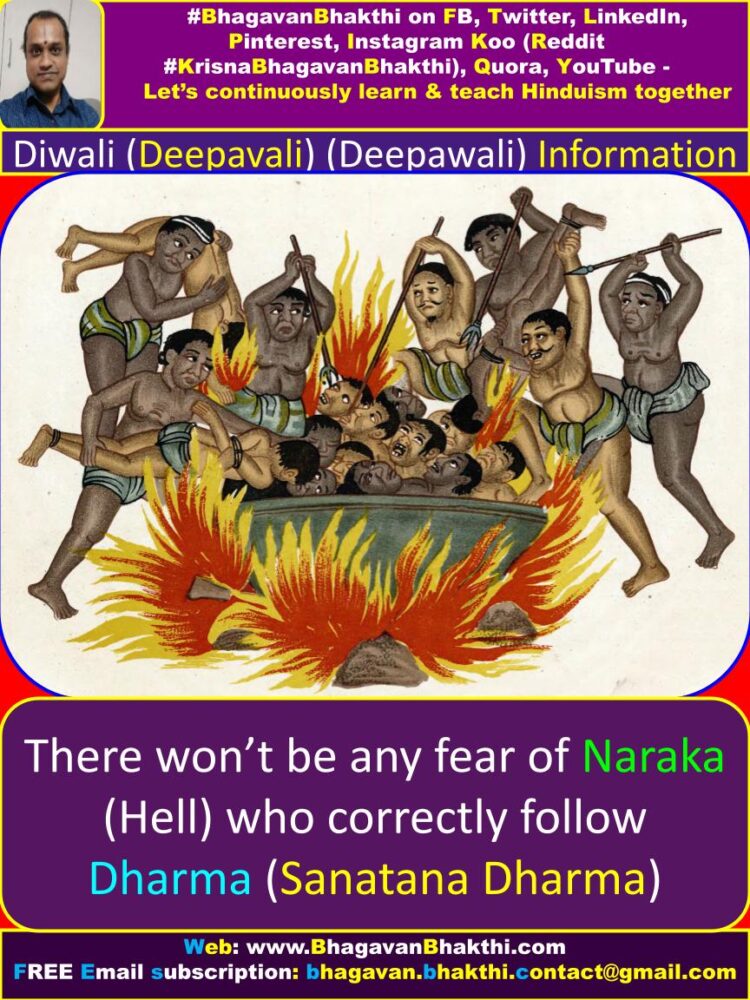
Abhyanga Snan (bath) is a full body massage and ritual bathing on the Naraka Chaturdashi day during Diwali (Deepavali) time.
In some regions, Abhyanga Snan (bath) is performed before sunrise. Before doing Abhyanga Snan (bath) – first have “Oil shastra” (applying oil) from sumangali strees (ladies who have husband). Then do have normal snan (bath).
Then do the abhyanga snan (bath) to the deities (idols) in your house. Then remains of the oil used for Devata Samarpana to be mixed with the oil and to be applied to the other members of your house.
Oil shastra shall be done with gingelly oil (अदरक का तेल).
Amavasya day : On fourth day, that is, on ‘amavasya’ (new moon) day, Sri Mahalakshmi pooja is done.
Bali Padyami : The fifth and final day is on ‘padya / padyami’. On this day, Lord Sri Vishnu in his Lord Sri Vamana avatar keeps the third foot on Sri Bali Chakravarti (Mahabali) head. This is the reason this day is called as ‘Bali Padyami‘.

Who is Bali Chakravarthi (Mahabali)?
Bali Chakravarthi (Mahabali) is the great grand son of Prahlada and the son of Virochana.
Bali Chakravarthi (Mahabali) real name was Indrasena.
Bali Chakravarthi (Mahabali) was born in the daitya / demon family of Hiranyakashipu, he was the daitya chakravarthi (King of the demons).
Even though Bali Chakravarthi (Mahabali) was a daitya (demon), he ruled the state with proper dharmanista (according to Dharma) and he was an expert in giving daana / daan / donation.
Bali Chakravarthi (Mahabali) led the Daitya (demon) team during Samudra manthana (manthan). Bali Chakravarthi (Mahabali) will become Lord Sri Indra Devi in the coming Saavarni manvantara (manvantar).
Story of Bali Chakravarthi (Mahabali) (Indrasena) as per Skanda purana (Reva khanda) is as given below:
In his previous life, Bali Chakravarthi (Mahabali) was a business man and was fond of women and was always wasting his time with various prostitute women.
Indrasena (Bali Chakravarthi) (Mahabali) had never done any punya kaaryas (good deeds) at all. But during his last stages, he gave the daana (daan) (donation) of whatever he had with him to various Brahmins (Brahmanas).
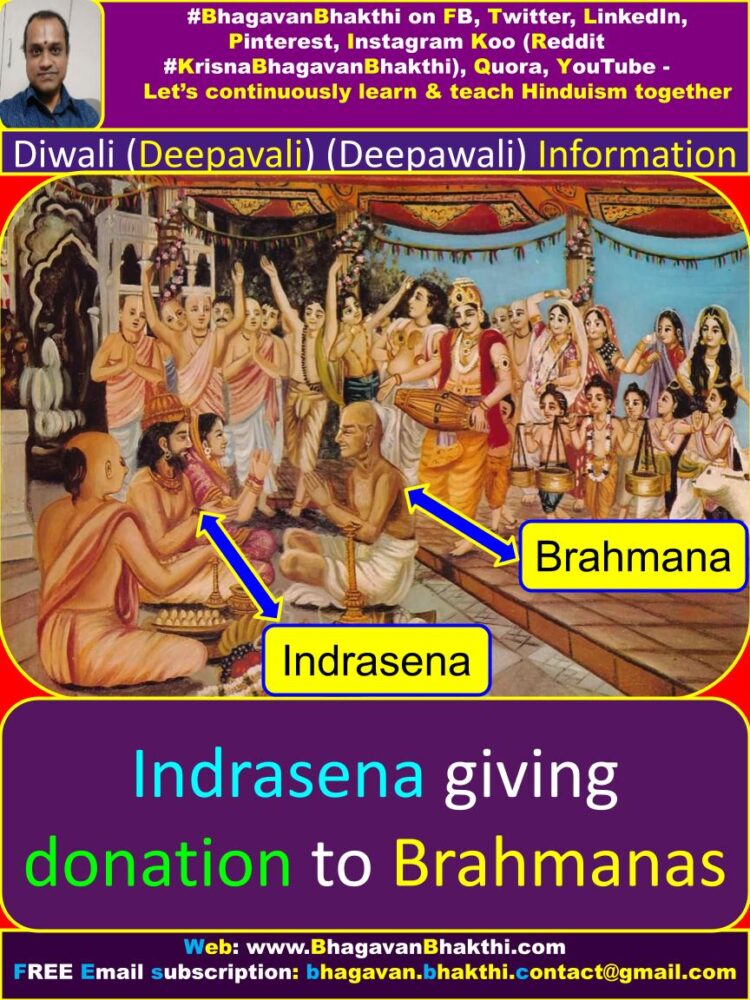
He died and the Lord Sri Yama’s soldiers took him to Yama Loka. There, Chitragupta opened his file and submitted before Lord Sri Yama Deva. His file was fully covered with sins only.
Lord Sri Yama Deva verified the file and surprised to note that he had the punya of daana (daan) (donation) at his last stage. He had the punya of becoming Lord Sri Indra Deva for 3 muhurthas (muhurats).
Lord Sri Yama Deva asked Indrasena as to whether he intends to use the punya (good deeds) first or the paapa (sins) first.
He opted for Lord Sri Indra Deva’s throne for 3 muhurthas (muhurats). Lord Sri Yama Deva agreed and asked Lord Sri Indra Deva to give the throne for 3 muhurthas (muhurats) to Indrasena.
After sitting in the throne for a very short time, he gave the daana (daan) (donation) whatever available in Indra Loka to Maharishi Vashishtha, Maharishi Vishwamitra, etc.
This punya (good deed) of giving daana (daan) (donation) at Indra Loka ensured that all his sins were destroyed and he was eligible for Lord Sri Indra Deva’s throne.
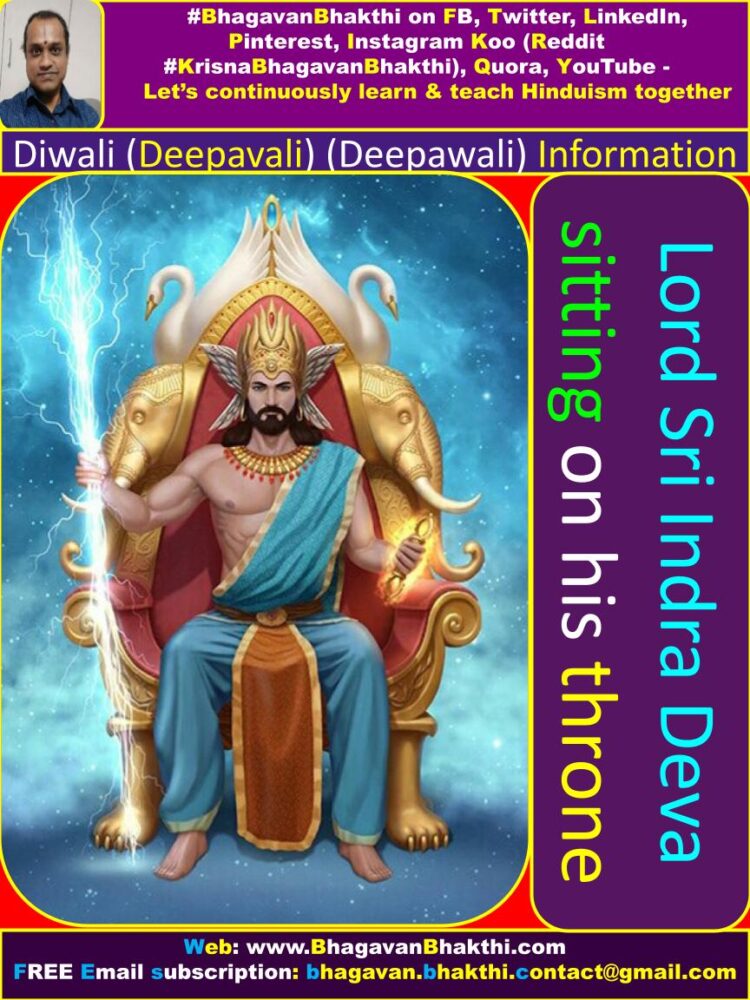
As such, he was born as the son of Virochana (grandson of Prahlada) and got the throne of Daitya vamsha (demon lineage).
Finally with the anugraha (blessings) of Lord Sri Vamana (Lord Sri Vishnu avatar) he was eligible for Lord Sri Indra Deva’s throne, which he will get in Saavarni manvantara (manvatar).
Bali Chakravarthi (Mahabali) son was Banasura (Vanasura), another daitya / demon. This Banasura (Vanasura) had thousand arms, he was a follower of Lord Shiva.
Banasura (Vanasura) had a boon from Lord Shiva to fight with Lord Sri Krishna. In the war, Lord Sri Krishna cuts off Banasura (Vanasura) 998 hands and spare’s his life.
Why is Bali Chakravarthi (Mahabali) is living in Patala Loka (Underworld) (Netherworld)?
Bali Chakravarthi (Mahabali) had the control of the entire world and he had occupied all the kingdoms and occupied the Devaloka (Svarga Loka) also by pushing out Lord Sri Indra Deva.
Bali Chakravarthi (Mahabali) wanted to be Lord Sri Indra Devi. For getting the throne of Lord Sri Indra Deva, one must do at least 100 Ashwamedha Yajnas. He had completed 99 Ashwamedha Yajnas, and was doing the 100th one.

He was doing the Yajna under the leadership of Shukracharya, who is the daitya (demon) Guru. Lord Sri Indra Deva (Here Lord Sri Indra Deva’s name is called as Purandara) approached Lord Sri Vishnu and sought his help.
At the same time, Aditi Devi, the mother of Devatas (Demigods) asked her husband Maharishi Kashyapa to protect Devatas (Demigods) from Bali chakravarthi (Mahabali).
So, both Aditi Devi and Maharishi Kashyapa approached Lord Sri Vishnu for help. Lord Sri Vishnu decided to be born as the son of Aditi Devi and Maharishi Kashyapa as “Lord Sri Vamana” for the nigraha (suppression) of the daityas (demons).
Bali Chakravarthi (Mahabali) was in the finishing stage of his 100th Yajna.
Lord Sri Vamana came to the place of Yajna. On seeing the handsome, attractive young Brahmachari (Lord Sri Vamana), Bali Chakravarthi (Mahabali) stood and did the ‘paada prakshalana‘ (cleaning of foot with water and later sprinkling that same water on our head) of Lord Sri Vamana.
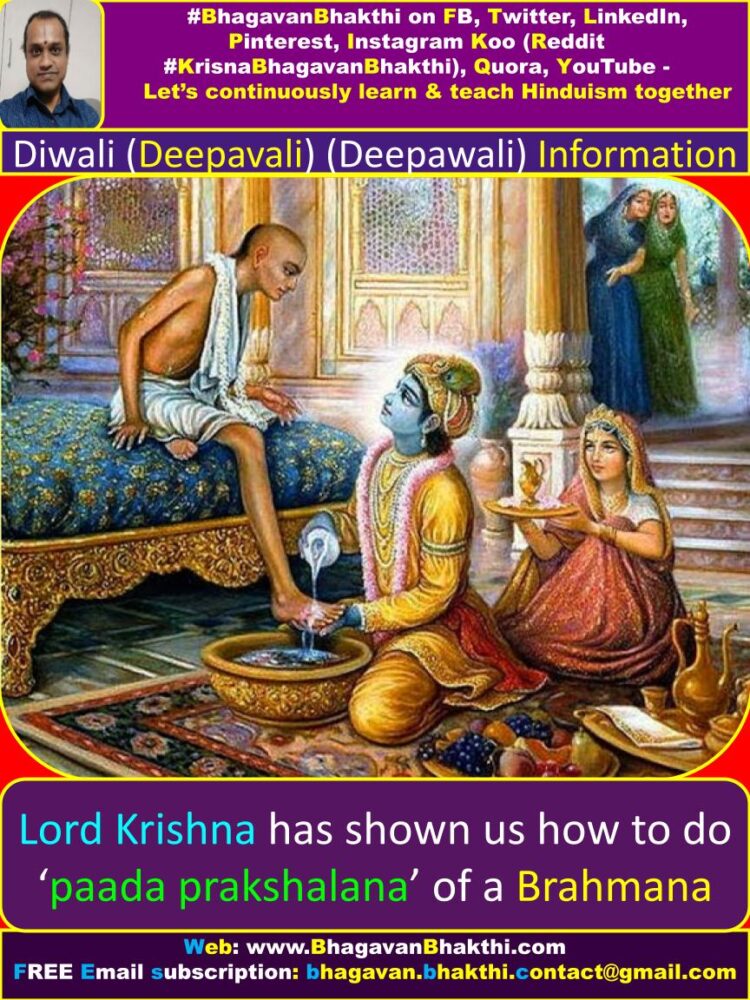
And then later asked Lord Sri Vamana as to what he (Mahabali) wants – a beautiful girl, kingdom, or ornaments, etc. Lord Sri Vamana said that he does not require anything, except 3 steps of land.
Shukracharya, the daitya (demon) Guru, warned Bali Chakravarthi (Mahabali) and told him not to accede to Lord Sri Vamana’s request.
But Bali Chakravarthi (Mahabali) went ahead for the daana / daan / donation of the 3 steps to Lord Sri Vamana. Getting angry at Bali Chakravarthi (Mahabali), Shukracharya cursed him that Bali Chakravarthi (Mahabali) shall loose all his kingdom.
Bali Chakravarthi (Mahabali) did the sankalpa (resolution) and started giving the three steps to Lord Sri Vamana.
Lord Sri Vamana extended himself to be that of ‘Trivikrama‘ (the kind of three worlds) to extend to the entire world from his very first step itself.
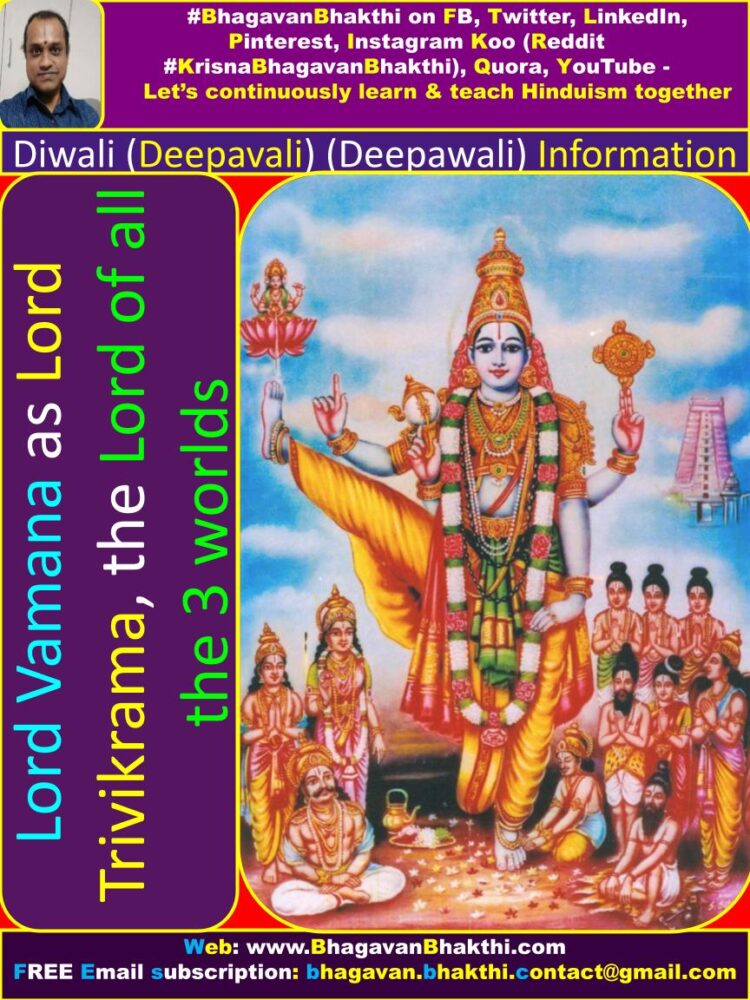
From the second step Lord Sri Vamana occupied the atala, vitala, sutala, patala lokas also. For the third step, there was no place.
Since Lord Sri Vamana could not place his foot anywhere on the earth and Bali Chakravarthi (Mahabali) offered his head itself and asked Lord Sri Trivikrama (Lord Sri Vamana) to keep his leg on his head.
Lord Sri Brahma Deva then asks Lord Sri Vamana to release Bali Chakravarthi (Mahabali) and thus Lord Sri Vamana keeping his ‘Vishnu paada / Paad’ which has the presence of Goddess Sri Ganga Devi, pushed him down to earth to Patala Loka.
And even today Lord Sri Vamana is guarding Bali Chakravarthi (Mahabali) in his Upendra Roopa (Lord Sri Vishnu’s avatar) in the Patala Loka.
Bali Chakravarthi (Mahabali) will be the next Lord Sri Indra Deva in the coming Manvantara (Manvantar).
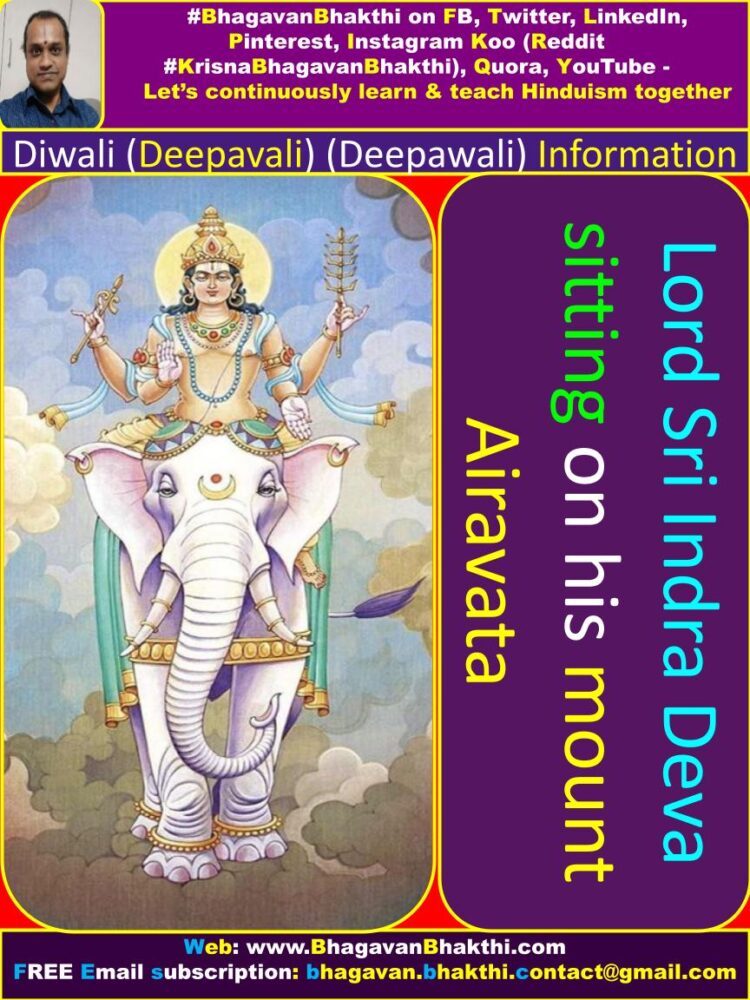
Bali Padyami half Muhurta (Muhurat):
There are 3½ muhurtas (muhurats) which are termed as Good Muhurtas (Muhurat) in Hinduism (Sanatan Dharma).
They are called as: Vijayadashami, Ugadi and Akshaya Tritiya which are full day muhurtas (muhurat), whereas Bali Padyami is termed as Half Muhurtas (for the first half day).
On this day, we need not look at the panchanga (Hindu calendar) for taaraabala, chandrabala, for the shubha karyas (auspicious works).
Whatever good works done on this day will fetch more punyas (good deeds). On this day also we have to do tailabhyanjana snan (should take bath by applying oil).
Bali pooja krama:
Bali Chakravarthi (Mahabli) was also given the boon that he will be allowed to rule the entire universe for one day in a year.
And on that day he can visit the earth, which is called as Bali Padyami day – the Kartika month, Shukla Paksha, Padya (Padyami) day.
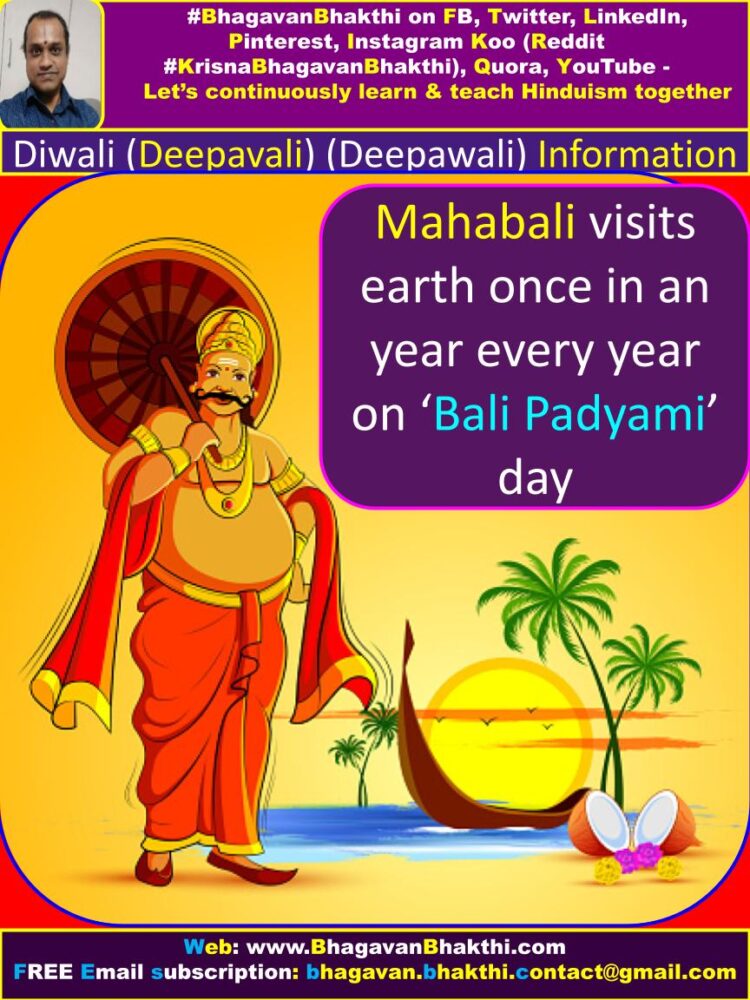
We have to sketch the Bali Chakravarthi (Mahabali) figure in rangoli or Gomaya (cow dung). Then we have to invite Bali Chakravarthi (Mahabali).
We have to put curds in front of Bali Chakravarthi (Mahabali). Ladies will enter the house, by pouring milk from outside, which is a method of inviting Goddess Sri Maha Lakshmi Devi.
From the Gomaya itself, we have to sketch the the fort with four gates and in the centre of the fort, one has to put the pillaari gopura and do the pooja with the following mantra:
baliraaja namastubhyaM virOchanasuta prabhO: | bhaviShyEMdra suraaraatE pUjOyaM pratigRuhyataam |
baliraaja namastubhyaM daityadaanavavaMdita: | iMdrashatrO amaraavatE viShNusaannidhyadO bhava|
Let us all pray to our Guru to show the right path. To get the right and correct lessons through out our life.
We should always pray to Sri Mukhyaprana Deva (Lord Hanuman) to show us the way of devotion towards Lord Sri Rama (Vishnu).
Let us thanks to Goddess Sri Maha Lakshmi Devi who has showered blessings through out our life. Finally, let us pray to Lord Sri Vishnu / Lord Sri Hari / Lord Sri Rama / Lord Sri Krishna to give us mukti / moksha / liberation.
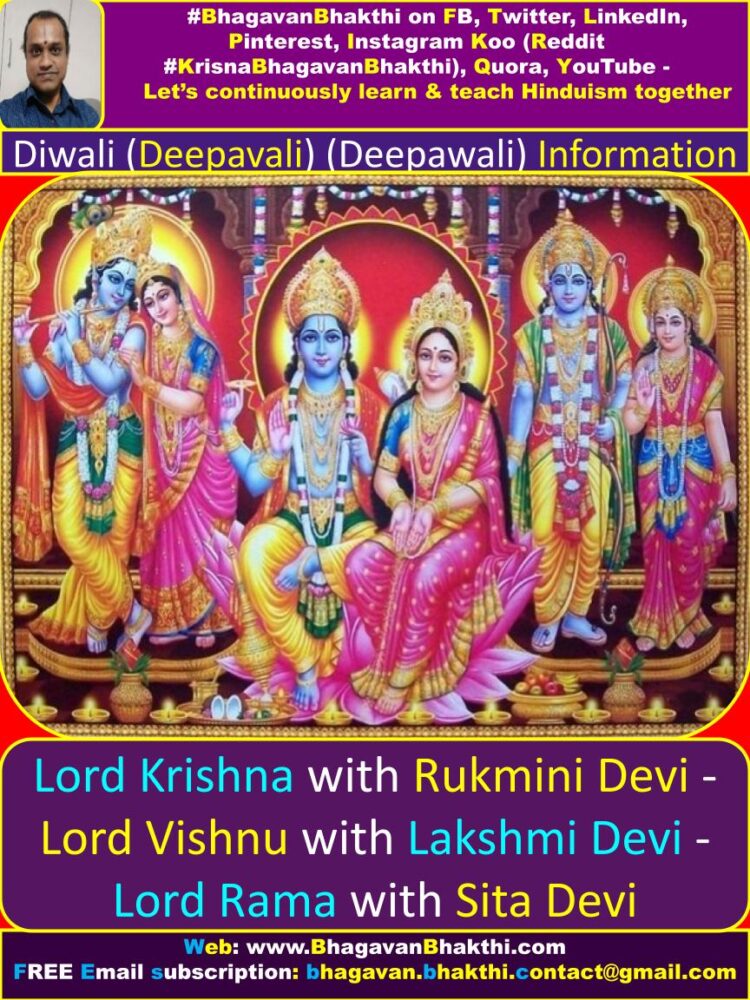
Shubha Diwali (Deepavali) (Deepawali) to you, your family and all you well wishers.
To know more about “Hindu festivals information“, please click the below link:
Continue reading about Hinduism (Sanatana Dharma) :
Rivers information in Hinduism (Sanatana Dharma)
Hinduism (Sanatana Dharma) information, facts, etc.
Mahabharata information, facts, significance, importance etc.
Ramayana information, facts, significance, importance, etc.
More information will be added to his post (article) on regular basis. Please visit again to know the updated information after some time.
To watch videos on #Hinduism #Sanskrit language, SUBSCRIBE to my YouTube channel from this below link:
#BhagavanBhakthi YouTube channel
To know more about “Lord Sri Vishnu stories, information, facts, significances, etc.“, please click the below link:
Lord Sri Vishnu stories, information, facts, significances, etc.
Dear friends, if you need any clarifications about this post, kindly let me know, I will definitely try to answer all of them.
Also your one LIKE, one COMMENT, One Share, one SUBSCRIPTION is highly important.
This will help to know the quality of this content and also it will be helpful to know if any improvements is required for the content.
If you feel this content is useful to you and has helped you to improve your knowledge, kindly share this with your well-wishers.
Because “SHARING MEANS CARING”.
For receive FREE EMAIL SUBSCRIPTION about #BhagavanBhakthi, you can send an email to [email protected] from your email ID.
NAMASTE!
SRI GURUBHYO NAMAHA
OM NAMO NARAYANAYA
Sri Krishnaarpanamastu